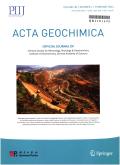Depicting Permian to Triassic thickness variation of the Kunlun-Qaidam Continental Arc: Implication for tectonic evolution of the South Kunlun Ocean
Abstract
Determining the evolutionary history of the Permian-Triassic Kunlun-Qaidam Continental Arc is essential to understanding the subduction and closure processes of the South Kunlun Ocean. In this paper, we utilize (La/Yb)N ratios collected from a filtered geochemical dataset on Permian to Triassic calc-alkaline rocks (55 wt%–68 wt% SiO2) and plutonic rocks within the Kunlun-Qaidam Continental Arc to reconstruct the spatiotemporal variation of the relative crustal thickness. Combined with known geologic observations, we discuss the subduction-accretionary tectonics of the South Kunlun Ocean and the topographic evolution of the Kunlun-Qaidam Continental Arc. Two episodes of crustal thickening and thinning were revealed. The reconstructed thickness reveals two crustal thickening and thinning events for the Kunlun-Qaidam Continental Arc from ca. 270 to 210 Ma. The southern sector of the Kunlun-Qaidam Continental Arc is about 7 km thicker than the northern portion, with a maximum thickness of about 55 km at ca. 270 and 230 Ma. The ca. 270 and 230 Ma crustal thickening events coincide with renewed northward subduction of the South Kunlun Ocean plate and ocean closure, respectively, whereas the ca. 270‒240 Ma and ca. 230‒210 Ma crustal thinning events may reflect slab break-off of the oceanic plate and lithospheric collapse during the post-collision extension, respectively.

 求助内容:
求助内容: 应助结果提醒方式:
应助结果提醒方式:


